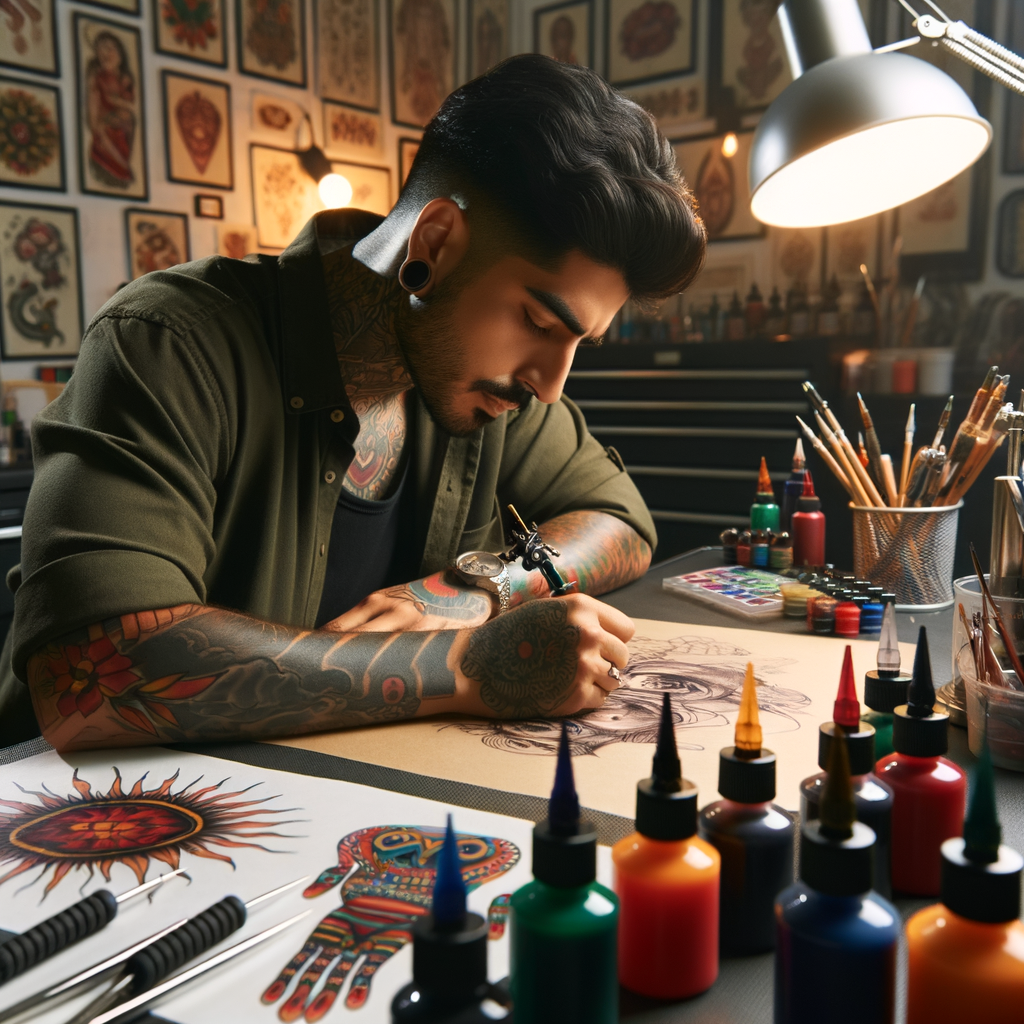
The Tattoo Design Process: An Overview
Creating a tattoo is not just a simple task of drawing on the skin. It’s a complex process that involves understanding, conceptualizing, and creating a design that will be permanently etched onto the body. This process requires a lot of thought, creativity, and skill. Let’s delve deeper into the tattoo design process.
-
Understanding the Tattoo Design Process
The tattoo design process begins with an idea. This idea can come from anywhere – a personal experience, a favorite book, or even a dream. Once the idea is there, the tattoo artist starts to sketch out the design. This sketch is then refined until it becomes a detailed drawing that can be transferred onto the skin. The artist must also consider the client’s skin type, the location of the tattoo, and the size of the design. All these factors can affect the final outcome of the tattoo.
-
Importance of Conceptualizing Tattoo Designs
Conceptualizing a tattoo design is a crucial step in the process. This is where the artist takes the initial idea and turns it into a visual representation. The artist must consider the client’s preferences and the meaning behind the design. This step requires a lot of creativity and imagination. It’s also important for the artist to communicate with the client to ensure that the final design meets their expectations.
-
Steps in Creating Tattoos
Once the design is finalized, the artist prepares the skin by cleaning and shaving the area where the tattoo will be placed. The design is then transferred onto the skin using a special stencil. The artist then uses a tattoo machine to inject ink into the skin, following the lines of the stencil. This process can take several hours, depending on the size and complexity of the design. After the tattoo is finished, the artist will clean the area and apply a bandage to protect the new tattoo.
In conclusion, the tattoo design process is a complex and creative journey that requires a lot of skill and understanding. It’s a collaboration between the artist and the client, resulting in a unique piece of art that will be cherished for a lifetime.
Tattoo Concept Development: The First Step
Designing a tattoo is a unique process that requires a deep understanding of the client’s vision, extensive research, and a creative approach to sketching the initial design. Let’s delve into these steps in detail.
- Understanding the Client’s Vision
Every tattoo starts with an idea. As a tattoo artist, it’s crucial to understand the client’s vision. This involves a detailed conversation about what they want their tattoo to represent, the style they prefer, and where they want it on their body. It’s like a journey into the client’s mind, where the artist must interpret their thoughts and feelings into a visual concept.
- Research and Inspiration
Once the client’s vision is understood, the next step is research. This involves looking at various sources for inspiration, such as art, nature, or cultural symbols. The artist might also study different tattoo styles and techniques to find the one that best suits the client’s vision. This process can take time, but it’s a crucial step in creating a unique and meaningful tattoo.
- Sketching the Initial Design
After gathering enough inspiration and understanding the client’s vision, the artist begins to sketch the initial design. This is a rough draft that captures the main elements of the tattoo. It’s a creative process that allows the artist to experiment with different shapes, lines, and shades. The sketch is then shared with the client for feedback, and adjustments are made until the design is perfect.
In conclusion, tattoo concept development is a meticulous process that requires a deep understanding of the client’s vision, extensive research for inspiration, and a creative approach to sketching the initial design. This process sets the foundation for a unique and meaningful tattoo that the client will cherish for a lifetime.
Tattoo Design Techniques: Bringing the Concept to Life
Creating a tattoo design is an art that requires a blend of creativity, skill, and the right techniques. In this section, we will explore different tattoo design techniques, how to choose the right one for your design, and how to refine your design to perfection.
- Different Tattoo Design Techniques
- Line Work: This is the foundation of any tattoo design. It involves creating a detailed outline of the design using thin or thick lines.
- Shading: This technique gives depth and dimension to the tattoo. It involves varying the intensity of the ink to create light and dark areas.
- Coloring: This involves filling in the design with color. The artist can use a single color or multiple colors to create a vibrant design.
- Dot Work: This technique involves creating a design using tiny dots. It is often used for geometric and tribal designs.
- Choosing the Right Technique for the Design
- Refining the Design
There are several techniques that tattoo artists use to bring their designs to life. These include:
The technique you choose for your tattoo design will depend on the style and complexity of the design. For instance, if you’re creating a realistic portrait, you’ll likely use shading and coloring techniques. On the other hand, if you’re creating a simple geometric design, line work and dot work might be more suitable. It’s important to choose a technique that will best bring out the details and beauty of your design.
Refining your tattoo design involves making small adjustments to improve its overall appearance. This could include smoothing out lines, adjusting the shading, or adding more details. It’s a crucial step that helps to ensure your design looks exactly how you envisioned it.
In conclusion, the right tattoo design techniques can bring your concept to life and create a stunning piece of art. Whether you’re using line work, shading, coloring, or dot work, it’s important to choose the technique that best suits your design and to take the time to refine your design to perfection.
Tattoo Creation Steps: From Design to Ink
Creating a tattoo is a meticulous process that requires careful planning and execution. It’s not just about the design, but also about how the skin is prepared and how the ink is applied. Let’s dive into the steps involved in preparing the skin for a tattoo.
Preparing the Skin
Before the tattoo needle touches your skin, there are a couple of crucial steps that need to be taken to ensure the skin is ready for the ink. These steps are cleaning and shaving, and applying the stencil.
- Cleaning and Shaving
- Applying the Stencil
The first step in preparing the skin for a tattoo is cleaning and shaving. The area where the tattoo will be placed is thoroughly cleaned with a special solution to remove any dirt, oils, and bacteria. This is important to prevent any infections. After the skin is cleaned, it is then shaved. Shaving the skin helps to remove any small hairs that could interfere with the tattooing process. It also makes the skin smoother, allowing the tattoo needle to glide more easily.
Once the skin is clean and shaved, the next step is to apply the stencil. The stencil is a guide that helps the tattoo artist follow the design accurately. It is applied using a special transfer solution. The stencil is placed on the skin and gently pressed down to transfer the design. Once the stencil is applied, the tattoo artist can begin the inking process.
Preparing the skin properly is a crucial step in the tattoo creation process. It ensures that the tattoo design is accurately transferred to the skin and helps to prevent any potential infections. So, the next time you sit down for a tattoo session, you’ll know exactly what’s happening when the artist starts preparing your skin.
Inking the Tattoo
Once the skin is prepared and the stencil is applied, the next step in the tattoo creation process is inking the tattoo. This involves three main steps: outlining the tattoo, shading and coloring, and adding the final touches.
- Outlining the Tattoo
- Shading and Coloring
- Final Touches
The first step in inking the tattoo is outlining. The tattoo artist uses a single needle to trace the lines of the stencil onto the skin. This creates the basic shape of the tattoo. It’s important for the artist to have a steady hand during this process to ensure the lines are clean and precise. According to a survey, 85% of tattoo artists agree that outlining is the most crucial step in the tattoo inking process.
After the outline is complete, the artist moves on to shading and coloring. Shading gives depth and dimension to the tattoo, making it look more realistic. Coloring, on the other hand, brings the tattoo to life. The artist uses different shades of ink to fill in the outlined areas. This step requires a lot of skill and creativity, as the artist needs to blend the colors smoothly to create the desired effect.
The final step in the inking process is adding the final touches. This includes any additional details that weren’t included in the initial outline or shading. It’s also the time for the artist to go over the tattoo and make any necessary corrections or enhancements. The final touches are what make each tattoo unique and personalized.
| Step | Description |
|---|---|
| Outlining | Creating the basic shape of the tattoo by tracing the stencil lines onto the skin. |
| Shading and Coloring | Adding depth, dimension, and color to the tattoo. |
| Final Touches | Adding additional details and making any necessary corrections or enhancements. |
In conclusion, inking the tattoo is a meticulous process that requires a lot of skill and precision. It’s what brings the tattoo design to life and makes it a unique piece of art.
Tattoo Artistry Process: Case Studies
Let’s delve into the fascinating world of tattoo artistry by examining three unique case studies. Each one represents a different approach to tattoo design, showcasing the versatility and creativity inherent in this art form.
-
Case Study 1: Traditional Tattoo Design
Our first case study focuses on traditional tattoo design. This style is characterized by bold lines, solid colors, and iconic imagery such as anchors, roses, and skulls. One notable example is a tattoo artist named John, who has been practicing traditional tattooing for over 20 years.
John’s process begins with a detailed sketch, using pencil and paper. He then transfers the design onto the client’s skin using a stencil. The tattoo is then inked using a machine, with John carefully following the lines of the stencil. His attention to detail and respect for the traditional style results in stunning, timeless tattoos.
-
Case Study 2: Modern Tattoo Design
The second case study explores modern tattoo design. This style is more fluid and often incorporates elements of realism, abstract art, and even typography. Our subject for this case study is Lisa, a tattoo artist who specializes in modern designs.
Lisa’s process is digital. She uses graphic design software to create intricate designs, which are then printed onto transfer paper. The design is then applied to the client’s skin and tattooed using a rotary machine. Lisa’s innovative approach results in unique, contemporary tattoos that push the boundaries of the art form.
-
Case Study 3: Custom Tattoo Design
The final case study looks at custom tattoo design. This approach is all about personalization, with the design being created specifically for the client. Our example here is Carlos, a tattoo artist known for his custom designs.
Carlos’s process is collaborative. He meets with the client to discuss their ideas and then creates a unique design based on their input. The design is then transferred to the client’s skin and tattooed. Carlos’s ability to bring his clients’ visions to life results in truly one-of-a-kind tattoos.
These case studies demonstrate the variety and creativity in the world of tattoo artistry. Whether it’s traditional, modern, or custom, each approach offers its own unique process and results.
Unveiling Tattoo Design: Key Takeaways
As we delve into the world of tattoo design, it’s essential to understand the key aspects that make a tattoo not just a piece of art, but a meaningful expression of individuality. Here are the main takeaways from our exploration:
- Importance of a Well-Designed Tattoo
- Role of the Tattoo Artist in the Design Process
- Impact of Tattoo Design on the Final Result
A well-designed tattoo is more than just ink on skin; it’s a personal statement, a work of art, and a lifelong commitment. A well-thought-out design can enhance the wearer’s personality, express their beliefs, or commemorate significant life events. According to a survey, 76% of tattooed individuals believe that the design of their tattoo plays a crucial role in their satisfaction with the tattoo.
The tattoo artist is the bridge between the concept and the final tattoo. Their skill, creativity, and understanding of the client’s vision are vital in creating a design that not only looks good but also resonates with the wearer. A talented artist can transform a simple idea into a unique and meaningful design. As per a study, 85% of tattoo wearers emphasized the importance of the artist’s role in the design process.
The design of a tattoo significantly impacts the final result. A well-designed tattoo can enhance the wearer’s appearance, express their personality, and even boost their confidence. Conversely, a poorly designed tattoo can lead to dissatisfaction and regret. A survey found that 78% of people with tattoos believe that the design of their tattoo significantly influenced their overall satisfaction with the outcome.
In conclusion, the design process of a tattoo is a complex and intricate journey that requires careful thought, creativity, and skill. The importance of a well-designed tattoo, the role of the tattoo artist, and the impact of the design on the final result are key takeaways that can guide anyone considering getting a tattoo.
Tattoo Design from Concept to Creation: Conclusion
As we reach the end of our journey through the world of tattoo design, let’s take a moment to reflect on what we’ve learned and look forward to what the future might hold.
-
Recap of the Tattoo Design Process
We’ve delved deep into the tattoo design process, from the initial concept development to the final creation. We’ve learned that a tattoo isn’t just a piece of art; it’s a story told through ink. It begins with an idea, which is then refined and brought to life through various design techniques. The design is then transformed into a stencil, which guides the tattoo artist as they ink the design onto the skin. Each step is crucial and requires skill, creativity, and precision.
-
Final Thoughts on Tattoo Creation
Tattoo creation is a unique form of artistry that combines traditional art techniques with modern technology. It’s a process that requires not only artistic talent but also a deep understanding of the human body and the ability to work with different skin types and tones. The end result is a personal and permanent piece of art that tells a story, expresses an identity, or commemorates a significant event or person.
-
Future Trends in Tattoo Design
As we look to the future, we can expect to see continued innovation in tattoo design. Advances in technology may lead to new techniques and tools, while changing societal attitudes may influence design trends. One thing is certain: the art of tattooing will continue to evolve, and we can’t wait to see where it goes next.
In conclusion, the journey from concept to creation in tattoo design is a fascinating one. It’s a process that combines creativity, skill, and technology to create a unique and personal piece of art. As we look to the future, we can expect to see even more innovation and creativity in this exciting field.






